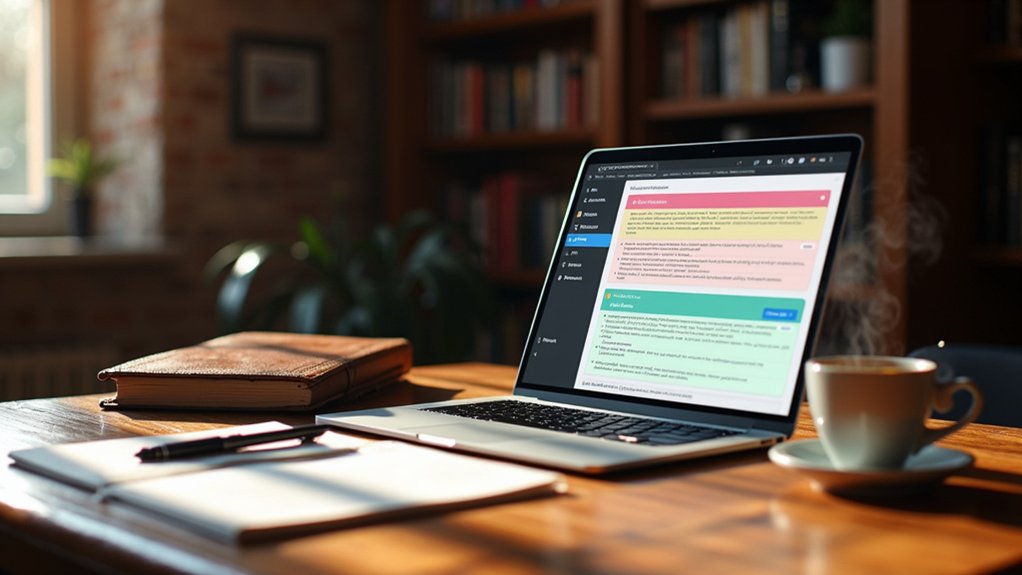Bricks Builder is a full WordPress theme offering a code-centric, Vue.js-powered visual editor with fast performance and clean, jQuery-free output. It features advanced dynamic data controls like Query Loops, a responsive three-panel layout, and supports direct code injection per element. While its core is flexible and developer-oriented, it has limited built-in templates and integrations, which may impact rapid prototyping. The next sections explore installation, customization options, and current limitations with practical technical insights.
Key Takeaways
- Bricks Builder is a full WordPress theme with a modern visual editor for designing headers, footers, and custom layouts.
- It offers a clean, fast interface powered by Vue.js, producing lightweight, jQuery-free front-end code for optimal performance.
- Users benefit from advanced features like Query Loops for dynamic content and responsive design controls for multiple device previews.
- Bricks supports custom code injection and branding but has fewer built-in elements and pre-made templates than established builders.
- Limited third-party integrations and a smaller community may present a steeper learning curve and reduced support for beginners.
Exploring the Core Features of Bricks Builder
Although Bricks Builder is implemented as a full WordPress theme, its architecture offers granular control over website structure by enabling direct visual editing of headers, footers, archives, and custom templates.
The builder’s interface integrates a left panel for inserting design elements, a top bar for site-wide settings, and a right panel for advanced granular options.
Bricks Builder’s dynamic data capabilities—such as Query Loops—allow developers to efficiently render content from custom post types, enabling flexible, data-driven templates.
With dynamic data and Query Loops, Bricks Builder empowers developers to craft flexible templates driven by custom post type content.
Its reliance on the Vue.js framework, eliminating JQuery from the front end, promotes high performance and fast interactivity.
Features like conditional element rendering, extensive typography and color controls, and responsiveness adjustments contribute to both search engine optimization SEO and superior user experience on all devices.
Getting Started: Installation and Setup
To begin using Bricks Builder, users must download the theme zip file from their account, upload it via Appearance > Themes in the WordPress dashboard, and activate it with the provided license key.
Initial setup options include enabling Bricks for specific post types and configuring general settings, such as autosave intervals and SVG upload permissions.
The interface immediately presents access to design elements, documentation, and settings panels for streamlined customization.
Downloading and Activating Bricks
Begin the Bricks installation process by purchasing a license—$99 permits use on a single website, while $249 covers unlimited sites.
After completing the purchase, users should download the Bricks theme zip file from their Bricks account dashboard.
The next step involves uploading this zip file to the WordPress websites via Appearance > Themes > Add New, followed by clicking the “Upload Theme” button.
Once uploaded, users need to activate the Bricks theme, after which a prompt will request the license key.
Entering the license key—found in the Bricks dashboard—unlocks all premium features and guarantees future updates.
Upon activation, the system redirects to a “Getting Started” screen, providing guidance for further configuration and builder setup.
Bricks supports enabling the builder for specific post types, especially pages.
Configuring Initial Theme Settings
Once Bricks is activated and the license key validated, users are presented with the initial configuration screen to establish core theme settings.
The setup process provides granular controls for Bricks Builder access by defining which post types utilize the builder and assigning user roles with editing or viewing privileges.
Within the general settings, administrators can activate SVG uploads for richer media assets and set the autosave interval, which defaults to 60 seconds for continuous design protection.
Custom CSS can be injected globally for advanced personalization, and theme styles—including color palettes and font families—are readily configurable.
Page settings, revision history, and device-specific layout adjustments guarantee robust control and adaptability.
- Effortlessly enable or restrict Bricks Builder access by user roles
- Inject custom CSS for advanced, site-wide styling
- Instantly safeguard progress with autosave
- Achieve pixel perfection across devices with responsive previews
Efficiently maneuvering the Bricks Builder interface relies on understanding its three-panel layout: a left panel dedicated to design elements, a top bar offering state controls and documentation access, and a right panel for additional options. Bricks Builder access initiates the workspace, placing editing with Bricks at the forefront for streamlined workflow. The Structure panel, located within the left panel, visualizes the page hierarchy, enabling precise element selection and adjustment. Contextual settings appear by selecting elements on the canvas, while responsive toggles on the top bar facilitate real-time device preview. Dynamic data integration and Flexbox-based arrangement further enhance customization and organization.
| Panel/Element | Functionality | Key Feature |
|---|---|---|
| Left Panel | Design elements, Structure | Hierarchical editing |
| Top Bar | State controls, Docs | Responsive modes |
| Right Panel | Options, Settings | Contextual adjustments |
| Canvas | Visual editing | Direct element access |
| Responsive Toggle | Device previews | Optimize for all screens |
Designing With Bricks: Elements, Styles, and Layouts
Constructing layouts in Bricks involves adding core design elements such as sections, containers, and blocks, each utilizing CSS Flexbox for structured, responsive arrangement.
The builder allows for precise manipulation of padding and margins directly within the visual interface, optimizing spatial control. Designers can assign CSS classes to elements for targeted customization or leverage default styles set at the theme level.
Bricks supports a custom color palette, accepting hex codes to impose strict branding. For advanced requirements, custom code can be injected on a per-element basis, extending functionality or styling.
Responsive design is integral, allowing real-time adjustments across device breakpoints to guarantee consistent user experiences.
- Effortlessly align content with Flexbox layouts
- Achieve pixel-perfect spacing through visual controls
- Maintain brand integrity with custom palettes and CSS classes
- Extend design with injectible custom code
Performance, Integrations, and Add-Ons
Many of Bricks Builder’s performance advantages stem from its architecture, particularly its use of the Vue.js framework to generate clean, jQuery-free front-end code. This approach reduces page load times and improves overall site responsiveness, making Bricks is a theme focused on speed and efficiency.
Dynamic data handling is achieved through Query Loops, enabling advanced customization and dynamic content population within templates.
Bricks Builder empowers advanced template customization with Query Loops, making dynamic content population seamless and highly flexible.
Regarding integrations, Bricks offers compatibility with a dedicated Crocoblock package that includes five premium plugins, expanding functionality for building dynamic WordPress websites. However, JetPlugins designed exclusively for Elementor remain incompatible.
While Bricks is a theme known for its lightweight design, its ecosystem of premade elements and templates is smaller than some competitors, influencing the range of available add-ons and integrations.
Challenges and Limitations of Bricks Builder
Bricks Builder currently offers a limited set of built-in elements and fewer pre-made templates, which can restrict rapid prototyping and reduce flexibility for users seeking ready-made design solutions.
Integration gaps are also present, as popular third-party tools like JetPlugins for Elementor are not compatible, and many advanced features require additional paid add-ons.
These factors may impact workflow efficiency and increase project costs, particularly for developers accustomed to broader ecosystem support.
Limited Template and Elements
One notable limitation of Bricks Builder is its comparatively small library of elements and premade templates, which restricts rapid prototyping and design flexibility for users accustomed to more established page builders.
The limited selection of elements means developers often need to add custom code or build components from scratch, increasing project complexity.
Fewer third-party add-ons further constrain extensibility, making it harder to achieve advanced layouts or specialized functionality without additional investment.
While Bricks prioritizes speed and clean code output, this minimalist approach may leave users, especially beginners, facing a steeper learning curve and longer development timelines.
- Fewer templates slow down project kickstarts
- Limited elements require more manual coding
- Scarcity of third-party add-ons restricts options
- Blank canvas approach increases initial setup effort
Integration and Add-on Gaps
Beyond the constraints of limited templates and elements, integration and add-on support present further challenges for Bricks Builder.
Bricks Builder access is currently limited to its theme-based architecture, which restricts flexibility for users preferring plugin-oriented solutions. The ecosystem’s reliance on advanced functionality frameworks—many of which are premium—can introduce additional costs and complexity, especially for developers seeking modular, extensible solutions.
Compared to established competitors, Bricks offers limited third-party add-ons and native marketing integrations, narrowing the pool of available features. Plugins designed for other builders, such as Elementor, remain incompatible, preventing seamless migration or reuse of existing workflows.
While specialized packages like Crocoblock exist, the broader integration environment remains sparse, impacting those requiring diverse, code-driven enhancements or automation within the Bricks setting.
Frequently Asked Questions
Is Bricks Builder Suitable for Beginners With No Coding Experience?
The current question evaluates suitability for beginners lacking coding experience. A user friendly interface, drag and drop functionality, and pre built templates allow non-developers to construct websites efficiently, minimizing technical barriers and eliminating the need for custom code implementation.
Does Bricks Builder Support Multilingual Websites Out of the Box?
The current question addresses multilingual compatibility. Bricks Builder does not natively support multilingual websites out of the box; instead, it integrates with translation plugins like WPML or Polylang, enabling language switcher features and content translation capabilities through third-party solutions.
Can I Transfer My Site From Another Builder to Bricks Easily?
Transferring a site from another builder involves a site migration process that may encounter builder compatibility issues. Users should expect to manually rebuild layouts, as automated transfers are limited. Design customization options must be reconfigured within the new builder’s framework.
How Often Does Bricks Builder Receive Updates and New Features?
Regarding update frequency and feature expansion, Bricks Builder typically rolls out updates every few weeks. Their development roadmap prioritizes user feedback, resulting in rapid code improvements, bug fixes, and the implementation of new features aligned with community requests.
What Kind of Customer Support Does Bricks Builder Offer?
The current question addresses available customer support channels. Users access live chat support for real-time assistance, extensive documentation resources for self-guided troubleshooting, and active community forums facilitating peer-to-peer code discussions and feature-oriented problem-solving within the platform’s ecosystem.
Conclusion
Bricks Builder establishes itself as a robust visual builder for WordPress, offering a clean React-based interface, flexible element controls, and granular CSS customization. Its native theme integration, advanced query loops, and dynamic data support streamline complex site builds without reliance on bloated add-ons. While its ecosystem and third-party compatibility are still maturing, Bricks’ performance optimizations and developer-centric features position it as a compelling alternative for users seeking efficiency, scalability, and code-level control in WordPress site development.




